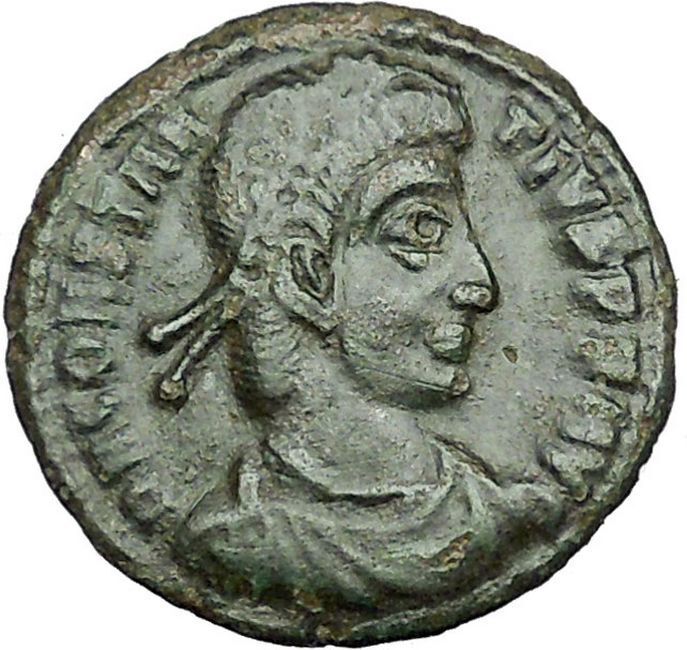|
Gratian – Roman Emperor: 367-383 A.D.
Bronze AE2 23mm (5.88 grams) Siscia mint: 378-383 A.D.
Reference: RIC 26a.1 (Siscia), C 30
DNGRATIANVSPFAVG – Diademed, draped and cuirassed bust right.
REPARATIOREIPVB Exe: BSISC – Gratian standing, facing, holding hand of kneeling
woman
with cornucopia to left and Victory on globe.
You are bidding on the exact item pictured,
provided with a Certificate of Authenticity and Lifetime Guarantee of
Authenticity.
Royal/Imperial symbols of power
Ruling dynasties often exploit pomp and ceremony with the use of
regalia
:
crowns
,
robes,
orb (globe) and sceptres
, some of which are
reflections of formerly practical objects. The use of language mechanisms also
support this differentiation with subjects talking of “the crown” and/or of “the
throne
” rather than referring directly to
personal names and items.
Monarchies
provide the most explicit
demonstration of tools to strengthen the elevation of leaders. Thrones sit high
on daises
leading to subjects lifting their gaze
(if they have permission) to contemplate the ruler. Architecture in general can
set leaders apart: note the symbolism inherent in the very name of the Chinese
imperial
Forbidden City
.
Flavius Gratianus (18 April/23 May 359 – 25 August
383), known usually by the
anglicised
name Gratian, was a
Western Roman Emperor
from 375 to 383.
He favoured the Christian religion against
Roman polytheism
, refusing the traditional polytheistic attributes of the
emperors and removing the
Altar of Victory
from the
Roman
Senate
.
//
Life
Gratian was the son of Emperor
Valentinian I
by Marina Severa
, and was born at
Sirmium
[ (now
Sremska Mitrovica
,
Serbia
) in
Pannonia
.
He was named after his grandfather
Gratian the Elder
. Gratian was first married to
Flavia Maxima Constantia
, daughter of
Constantius II
. His second wife was
Laeta
. Both
marriages remained childless. His stepmother was Empress
Justina
and his paternal half siblings were Emperor
Valentinian II
,
Galla
and Justa.
On 4 August 367 he received from his father the title of
Augustus
. On the death of Valentinian (17 November 375), the troops in
Pannonia proclaimed his infant son (by a second wife Justina) emperor under the
title of
Valentinian II
.
Gratian acquiesced in their choice; reserving for himself the
administration of the
Gallic
provinces
, he handed over
Italy
,
Illyricum
and
Africa
to Valentinian and his mother, who fixed their residence at
Mediolanum
.
The division, however, was merely nominal, and the real authority remained in
the hands of Gratian.
The
Eastern Roman Empire
was under the rule of his uncle
Valens
. In May,
378 Gratian completely defeated the
Lentienses
,
the southernmost branch of the
Alamanni
,
at the
Battle of Argentovaria
, near the site of the modern
Colmar
. Later
that year, Valens met his death in the
Battle of Adrianopole
on 9 August. Valens refused to wait for Gratian and
his army to arrive and assist in defeating the host of
Goths
,
Alans
and
Huns; as a result,
two-thirds of the eastern Roman army were killed as well.
In the same year, the government of the Eastern Empire
devolved upon Gratian, but feeling himself unable to resist unaided the
incursions of the barbarians, he promoted
Theodosius I
on 19 January 379 to govern that portion of the empire.
Gratianus and Theodosius then cleared the
Balkans
of
barbarians
in the
Gothic War (376-382)
.
For some years Gratian governed the empire with energy and
success but gradually sank into indolence, occupying himself chiefly with the
pleasures of the chase, and became a tool in the hands of the
Frankish
general Merobaudes
and bishop
St. Ambrose
of Milan
.
By taking into his personal service a body of Alans, and
appearing in public in the dress of a
Scythian
warrior, after the disaster of the Battle of Adrianopole, he
aroused the contempt and resentment of his
Roman troops
. A Roman general named
Magnus Maximus
took advantage of this feeling to raise the standard of
revolt in
Britain
and invaded Gaul
with a large army. Gratian, who was then in
Paris
, being
deserted by his troops, fled to
Lyon. There,
through the treachery of the governor, Gratian was delivered over to one of the
rebel generals, Andragathius, and assassinated on 25 August 383.
Empire
and religion
The reign of Gratian forms an important epoch in
ecclesiastical history, since during that period
Orthodox Christianity
for the first time became dominant throughout the
empire.
Under the influence of Ambrosius, Gratian prohibited
Pagan worship
at Rome
; refused to
wear the insignia of the
pontifex maximus
as unbefitting a
Christian
;
removed the
Altar of Victory
from the
Senate
House
at Rome, despite protests of the pagan members of the Senate, and
confiscated its revenues; forbade legacies of real property to the
Vestals
; and abolished other privileges belonging to them and to the
pontiffs. Nevertheless he was still
deified
after his death.
Gratian also published an edict that all their subjects
should profess the faith of the bishops of Rome and Alexandria (i.e., the Nicene
faith). The move was mainly thrust at the various beliefs that had arisen out of
Arianism
,
but smaller dissident sects, such as the
Macedonians
, were also prohibited.
The Roman Empire (Latin:
Imperium Romanum) was the post-Republican
period of the
ancient Roman civilization
, characterised by an
autocratic
form of government and large
territorial holdings in Europe and around the Mediterranean.

The Roman Empire at its greatest extent,
during the reign of Trajan
in 117 AD
The 500-year-old
Roman Republic
, which preceded it, had been
weakened and
subverted
through several
civil wars
. Several events are commonly
proposed to mark the transition from Republic to Empire, including
Julius Caesar
‘s appointment as perpetual
dictator
(44 BC), the
Battle of Actium
(2
September 31 BC), and the Roman Senate’s granting to
Octavian
the
honorific
Augustus
(16 January
27 BC).
Roman expansion began in the days of the Republic, but the Empire reached its
greatest extent under Emperor
Trajan
: during his reign (98 to 117 AD) the
Roman Empire controlled approximately 6.5 million km2
of land surface. Because of the Empire’s vast extent and long endurance, the
institutions and culture of Rome had a profound and lasting influence on the
development of language, religion, architecture, philosophy, law, and forms of
government in the territory it governed, particularly Europe, and by means of
European expansionism throughout the modern world.
In the late 3rd century AD,
Diocletian
established the practice of dividing
authority between four co-emperors (known as the
tetrarchy
) in order to better secure the vast
territory, putting an end to the
Crisis of the Third Century
. During the
following decades the Empire was often divided along an East/West axis. After
the death of
Theodosius I
in 395 it was divided for the last
time.
The
Western Roman Empire
collapsed
in 476 as
Romulus Augustus
was forced to abdicate to the
Germanic
warlord
Odoacer
. The Eastern Roman or
Byzantine Empire
ended in 1453 with the death
of
Constantine XI
and the
capture of Constantinople
to
Mehmed II
, leader of the
Ottoman Turks
.
Government
Emperor
The powers of an emperor (his
imperium
) existed, in theory at least, by
virtue of his “tribunician powers” (potestas tribunicia) and his
“proconsular powers” (imperium proconsulare). In theory, the tribunician
powers (which were similar to those of the
Plebeian Tribunes
under the old republic) made
the Emperor’s person and office sacrosanct, and gave the Emperor authority over
Rome’s civil government, including the power to preside over and to control the
Senate.
The proconsular powers (similar to those of military governors, or
Proconsuls
, under the old Republic) gave him
authority over the Roman army. He was also given powers that, under the
Republic, had been reserved for the
Senate
and the
assemblies
, including the right to declare war,
to ratify treaties, and to negotiate with foreign leaders.
The emperor also had the authority to carry out a range of duties that had
been performed by the
censors
, including the power to control Senate
membership. In addition, the emperor controlled the
religious institutions
, since, as emperor, he
was always
Pontifex Maximus
and a member of each of
the four major priesthoods. While these distinctions were clearly defined during
the early Empire, eventually they were lost, and the emperor’s powers became
less constitutional and more monarchical.
Realistically, the main support of an emperor’s power and authority was the
military. Being paid by the imperial treasury, the legionaries also swore an
annual military oath of loyalty towards him, called the
Sacramentum
.
The death of an emperor led to a crucial period of uncertainty and crisis. In
theory the Senate was entitled to choose the new emperor, but most emperors
chose their own successors, usually a close family member. The new emperor had
to seek a swift acknowledgement of his new status and authority in order to
stabilize the political landscape. No emperor could hope to survive, much less
to reign, without the allegiance and loyalty of the
Praetorian Guard
and of the legions. To secure
their loyalty, several emperors paid the
donativum
, a monetary reward.
Senate
While the
Roman assemblies
continued to meet after the
founding of the Empire, their powers were all transferred to the
Roman Senate
, and so senatorial decrees (senatus
consulta) acquired the full force of law.
In theory, the Emperor and the Senate were two equal branches of government,
but the actual authority of the Senate was negligible and it was largely a
vehicle through which the Emperor disguised his autocratic powers under a cloak
of republicanism. Although the Senate still commanded much prestige and respect,
it was largely a glorified
rubber stamp
institution. Stripped of most of
its powers, the Senate was largely at the Emperor’s mercy.
Many emperors showed a certain degree of respect towards this ancient
institution, while others were notorious for ridiculing it. During Senate
meetings, the Emperor sat between the two
consuls
,[18]
and usually acted as the presiding officer. Higher ranking senators spoke before
lower ranking senators, although the Emperor could speak at any time.[18]
By the 3rd century, the Senate had been reduced to a glorified municipal body.
Senators and
equestrians
No emperor could rule the Empire without the Senatorial order and the
Equestrian order
. Most of the more important
posts and offices of the government were reserved for the members of these two
aristocratic orders. It was from among their ranks that the provincial
governors, legion commanders, and similar officials were chosen.
These two classes were hereditary[citation
needed] and mostly closed to outsiders. Very
successful and favoured individuals could enter, but this was a rare occurrence.
The career of a young aristocrat was influenced by his family connections and
the favour of patrons. As important as ability, knowledge, skill, or competence,
patronage was considered vital for a successful career and the highest posts and
offices required the Emperor’s favour and trust.
Senatorial order
The son of a senator was expected to follow the
Cursus honorum
, a
career ladder
, and the more prestigious
positions were restricted to senators only. A senator also had to be wealthy;
one of the basic requirements was the wealth of 12,000 gold
aurei
(about 100 kg of gold), a figure which
would later be raised with the passing of centuries.
Equestrian order
Below the Senatorial order was the Equestrian order. The requirements and
posts reserved for this class, while perhaps not so prestigious, were still very
important. Some of the more vital posts, like the governorship of
Egypt
(Latin Aegyptus), were even
forbidden to the members of the Senatorial order and available only to
equestrians.
Military
Legions
During and after the civil war, Octavian reduced the huge number of the
legions
(over 60) to a much more manageable and
affordable size (28). Several legions, particularly those with doubtful
loyalties, were simply disbanded. Other legions were amalgamated, a fact
suggested by the title Gemina (Twin).
In AD 9, Germanic tribes wiped out three full legions in the
Battle of the Teutoburg Forest
. This disastrous
event reduced the number of the legions to 25. The total of the legions would
later be increased again and for the next 300 years always be a little above or
below 30.
Augustus also created the
Praetorian Guard
: nine
cohorts
ostensibly to maintain the public peace
which were garrisoned in Italy. Better paid than the legionaries, the
Praetorians also served less time; instead of serving the standard 25 years of
the legionaries, they retired after 16 years of service.
Auxilia
While the
auxilia
(Latin: auxilia = supports) are
not as famous as the legionaries, they were of major importance. Unlike the
legionaries, the auxilia were recruited from among the non-citizens. Organized
in smaller units of roughly cohort strength, they were paid less than the
legionaries, and after 25 years of service were rewarded with
Roman citizenship
, also extended to their sons.
According to Tacitus
there were roughly as many auxiliaries
as there were legionaries. Since at this time there were 25 legions of around
5,000 men each, the auxilia thus amounted to around 125,000 men, implying
approximately 250 auxiliary regiments.
Navy
The Roman navy
(Latin: Classis, lit.
“fleet”) not only aided in the supply and transport of the legions, but also
helped in the protection of the frontiers in the rivers
Rhine
and
Danube
. Another of its duties was the
protection of the very important maritime trade routes against the threat of
pirates. Therefore it patrolled the whole of the Mediterranean, parts of the
North Atlantic
(coasts of Hispania, Gaul, and
Britannia), and had also a naval presence in the
Black Sea
. Nevertheless the army was considered
the senior and more prestigious branch.
Provinces
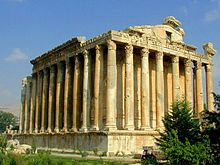
The
Temple of Bacchus
in
Baalbec
,
Lebanon
Until the Tetrarchy
(296 AD) Roman provinces (lat.
provincae) were administrative and territorial units of the Roman Empire
outside of
Italy
. In the old days of the Republic the
governorships of the provinces were traditionally awarded to members of the
Senatorial Order
. Augustus’ reforms changed
this policy.
Imperial provinces
Augustus created the
Imperial provinces
. Most, but not all, of the
Imperial provinces were relatively recent conquests and located at the borders.
Thereby the overwhelming majority of legions, which were stationed at the
frontiers, were under direct Imperial control. Very important was the
Imperial province of Egypt
, the major
breadbasket
of the Empire, whose
grain supply
was vital to feed the masses in
Rome. It was considered the personal fiefdom of the Emperor, and Senators were
forbidden to even visit this province. The governor of Egypt and the commanders
of any legion stationed there were not from the Senatorial Order, but were
chosen by the Emperor from among the members of the lower
Equestrian Order
.
Senatorial provinces
The old traditional policy continued largely unchanged in the
Senatorial provinces
. Due to their location,
away from the borders, and to the fact that they were under longer Roman
sovereignty and control, these provinces were largely peaceful and stable. Only
a single legion was based in a Senatorial province:
Legio III Augusta
, stationed in the Senatorial
province of
Africa
(modern northern Algeria).
The status of a province was subject to change; it could change from
Senatorial towards Imperial, or vice-versa. This happened several times
[26]
during Augustus’ reign. Another
trend was to create new provinces, mostly by dividing older ones, or by
expanding the Empire.
Religion
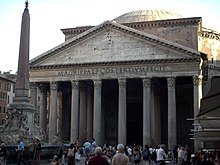
The
Pantheon
, the present structure
built during
Hadrian
‘s reign, was dedicated to
the worship of all Roman deities.
As the Empire expanded, and came to include people from a variety of
cultures, the worship of an ever increasing number of
deities
was tolerated and accepted. The
Imperial government, and the Romans in general, tended to be very tolerant
towards most religions and cults, so long as they did not cause trouble. This
could easily be accepted by other faiths as Roman liturgy and ceremonies were
frequently tailored to fit local culture and identity. Since the Romans
practiced polytheism they were also able to easily assimilate the gods of the
peoples the Empire conquered.
An individual could attend to both the Roman gods representing his Roman
identity and his own personal faith, which was considered part of his personal
identity. There were periodic persecutions of various religions at various
points in time, most notably that of Christians. As the historian
Edward Gibbon
noted, however, most of the
recorded histories of Christian persecutions come to us through the Christian
church, which had an incentive to exaggerate the degree to which the
persecutions occurred. The non-Christian contemporary sources only mention the
persecutions passingly and without assigning great importance to them.
Imperial cult
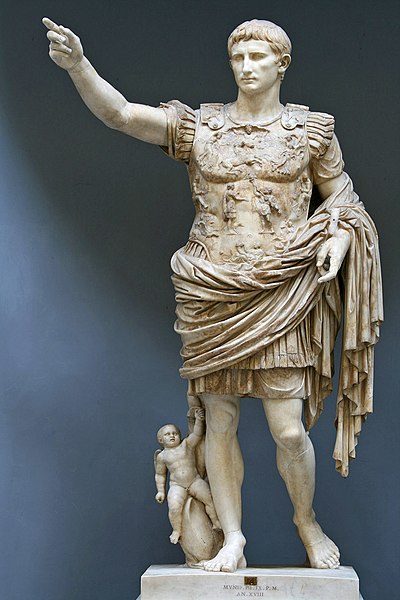
The
Augustus of Prima Porta
,
showing
Augustus
in military outfit holding
a consular baton (now broken off)
In an effort to enhance loyalty, the inhabitants of the Empire were called to
participate in the
Imperial cult
to revere (usually deceased)
emperors as demigods
. Few emperors claimed to be Gods while
living, with the few exceptions being emperors who were widely regarded at the
time to be insane (such as
Caligula
). Doing so in the early Empire would
have risked revealing the shallowness of what the Emperor
Augustus
called the “restored Republic” and
would have had a decidedly eastern quality to it. Since the tool was mostly one
the Emperor used to control his subjects, its usefulness would have been
greatest in the chaotic later Empire, when the emperors were often Christians
and unwilling to participate in the practice.
Usually, an emperor was deified after his death by his successor in an
attempt by that successor to enhance his own prestige. This practice can be
misunderstood, however, since “deification” was to the ancient world what
canonization is to the Christian world. Likewise, the term “god” had a different
context in the ancient world. This could be seen during the years of the
Roman Republic
with religio-political practices
such as the disbanding of a Senate session if it was believed the gods
disapproved of the session or wished a particular vote. Deification was one of
the many honors a dead emperor was entitled to, as the Romans (more than modern
societies) placed great prestige on honors and national recognitions.
The importance of the Imperial cult slowly grew, reaching its peak during the
Crisis of the Third Century
. Especially in the
eastern half of the Empire, imperial cults grew very popular. As such it was one
of the major agents of
romanization
. The central elements of the cult
complex were next to a temple; a
theatre
or
amphitheatre
for gladiator displays and other
games and a public bath complex
. Sometimes the imperial
cult was added to the cults of an existing temple or celebrated in a special
hall in the bath complex.
The seriousness of this belief is unclear. Some Romans ridiculed the notion
that a Roman emperor was to be considered a living god, or would even make fun
of the deification of an emperor after his death.
Seneca the Younger
parodied the notion of
apotheosis in his only known satire
The Pumpkinification of Claudius
, in which
the clumsy and ill-spoken
Claudius
is transformed not into a god, but a
pumpkin or gourd
. An element of mockery was present even
at Claudius’s funeral, and
Vespasian
‘s purported last words were Væ,
puto deus fio, “Oh dear! I think I’m becoming a god!”.
Absorption of
foreign cults
Since Roman religion did not have a core belief that excluded other
religions, several foreign gods and cults became popular.
The worship of Cybele
was the earliest, introduced from around
200 BC. Isis
and
Osiris
were introduced from Egypt a century
later. Bacchus
and
Sol Invictus
were quite important and
Mithras
became very popular with the military.
Several of these were
Mystery cults
. In the 1st century BC
Julius Caesar
granted Jews the freedom to
worship in Rome as a reward for their help in Alexandria.
Controversial
religions
Druids
Druids
were considered as essentially
non-Roman: a prescript of
Augustus
forbade Roman citizens to practice
“druidical” rites.
Pliny
reports that under
Tiberius
the druids were suppressed—along with
diviners and physicians—by a decree of the Senate, and
Claudius
forbade their rites completely in
AD 54.
Judaism
While Judaism was largely accepted, as long as Jews paid the
Jewish Tax
after 70 AD, there was
anti-Judaism in the pre-Christian Roman Empire
and there were several
Jewish-Roman wars
.
The Crisis under
Caligula
(37–41) has been proposed as the
“first open break between Rome and the Jews”, even though problems were already
evident during the
Census of Quirinius
in 6 and under
Sejanus
(before 31).
Until the rebellion in Judea in AD 66, Jews were generally protected. To get
around Roman laws banning secret societies and to allow their freedom of
worship, Julius Caesar declared Synagogues were colleges. Tiberius forbade
Judaism in Rome but they quickly returned to their former protected status.
Claudius expelled Jews from the city; however, the passage of Suetonius is
ambiguous: “Because the Jews at Rome caused continuous disturbances at the
instigation of Chrestus he [Claudius] expelled them from the city.” Chrestus
has been identified as another form of Christus; the disturbances may
have been related to the
arrival of the first Christians
, and that the
Roman authorities, failing to distinguish between the Jews and the early
Christians, simply decided to expel them all.
Historians debate whether or not the Roman government distinguished between
Christians and Jews
prior to Nerva’s
modification of the
Fiscus Judaicus
in 96. From then on, practising
Jews paid the tax; Christians did not.[34]
Christianity

The Christian Martyrs’ Last Prayer, by
Jean-Léon Gérôme
(1883). Roman
Colosseum
.
Christianity
emerged in
Roman Judea
as a
Jewish religious sect
in the 1st century AD.
The religion gradually spread out of
Jerusalem
, initially establishing major bases
in first Antioch
, then
Alexandria
, and over time throughout the Empire
as well as beyond.
Christianity shares numerous traits with other mystery cults that existed in
Rome at the time. Early Christianity placed a strong emphasis on baptism, a
ritual which marked the convert as having been inducted into the mysteries of
the faith. The focus on a belief in salvation and the afterlife was another
major similarity to other mystery cults. The crucial difference between
Christianity and other mystery cults was the
monotheism
of Christianity. Early Christians
thus refused to participate in civic cults because of these monotheistic
beliefs, leading to their persecution.
For the first two centuries of the
Christian era
, Imperial authorities largely
viewed Christianity simply as a Jewish sect rather than a distinct religion. No
emperor issued general laws against the faith or its Church, and persecutions,
such as they were, were carried out under the authority of local government
officials. A surviving letter from
Pliny the Younger
, governor of Bythinia, to the
Emperor Trajan
describes his persecution and executions
of Christians; Trajan notably responded that Pliny should not seek out
Christians nor heed anonymous denunciations, but only punish open Christians who
refused to recant.
Suetonius
mentions in passing that during the
reign of Nero
“punishment was inflicted on the
Christians, a class of men given to a new and mischievous
superstition
” (superstitionis novae ac
maleficae). He gives no reason for the punishment.
Tacitus
reports that after the
Great Fire of Rome
in AD 64, some among the
population held Nero responsible and that the emperor attempted to deflect blame
onto the Christians.
One of the earliest persecutions occurred in
Gaul at
Lyon in 177
. Persecution was often local and
sporadic, and some Christians welcomed
martyrdom as a testament of faith
.[39]
The
Decian persecution
(246–251) was a serious
threat to the Church, but while it potentially undermined the religious
hierarchy in urban centers, ultimately it served to strengthen Christian
defiance.[40]
Diocletian
undertook what was to be the
most severe and last major persecution of Christians
,
lasting from 303 to 311. Christianity had become too widespread to suppress, and
in 313, the
Edict of Milan
made tolerance the official
policy.
Constantine I
(sole ruler 324–337) became the
first Christian emperor, and in 380
Theodosius I
established Christianity as the
official religion.
By the 5th century Christian hegemony had rapidly changed the Empire’s
identity even as the Western provinces collapsed. Those who practiced the
traditional polytheistic religions were persecuted, as were Christians regarded
as heretics by the authorities in power.
Languages
The language of Rome before its expansion was
Latin
, and this became the empire’s official
language. By the time of the imperial period Latin had developed two
registers
: the “high” written
Classical Latin
and the “low” spoken
Vulgar Latin
. While Classical Latin remained
relatively stable, even through the
Middle Ages
, Vulgar Latin as with any spoken
language was fluid and evolving. Vulgar Latin became the
lingua franca
in the western provinces, later
evolving into the modern
Romance languages
:
Italian
,
French
,
Portuguese
,
Spanish
,
Romanian
, etc. Greek and Classical Latin were
the languages of literature, scholarship, and education.
Although Latin remained the most widely spoken language in the West, through
to the
fall of Rome
and for some centuries afterwards,
in the East the
Greek language
was the literary language and
the lingua franca. The Romans generally did not attempt to supplant local
languages. They generally left established customs in place and only gradually
introduced typical Roman cultural elements including the Latin language.[43]
Along with Greek, many other languages of different tribes were used but almost
without expression in writing.
Greek was already widely spoken in many cities in the east, and as such, the
Romans were quite content to retain it as an administrative language there
rather than impede bureaucratic efficiency. Hence, two official secretaries
served in the Roman Imperial court, one charged with correspondence in Latin and
the other with correspondence in Greek for the East.[44]
Thus in the Eastern Province, as with all provinces, original languages were
retained.
Moreover, the process of hellenisation widened its scope during the Roman
period, for the Romans perpetuated
“Hellenistic”
culture,[47][48][nb
4] but with all the trappings of
Roman
improvements. This further spreading of
“Hellenistic” culture (and therefore language) was largely due to the extensive
infrastructure (in the form of entertainment, health, and education amenities,
and extensive transportation networks, etc.) put in place by the Romans and
their tolerance of, and inclusion of, other cultures, a characteristic which set
them apart from the xenophobic nature of the Greeks preceding them.
Since the Roman annexation of Greece in 146 BC, the Greek language gradually
obtained a unique place in the Roman world, owing initially to the large number
of Greek slaves in Roman households. In Rome itself Greek became the second
language of the educated elite.It became the common language in the early
Church
(as its major centers in the early
Christian period were in the East), and the language of scholarship and the
arts.
However, due to the presence of other widely spoken languages in the densely
populated east, such as
Coptic
,
Syriac
,
Armenian
,
Aramaic
and
Phoenician
(which was also extensively spoken
in North Africa), Greek never took as strong a hold beyond Asia Minor (some
urban enclaves notwithstanding) as Latin eventually did in the west. This is
partly evident in the extent to which the derivative languages are spoken today.
Like Latin, the language gained a
dual nature
with the literary language, an
Attic Greek
variant, existing alongside spoken
language, Koine Greek
, which evolved into
Medieval
or Byzantine Greek (Romaic).
By the 4th century AD, Greek no longer held such dominance over Latin in the
arts and sciences as it had previously, resulting to a great extent from the
growth of the western provinces. This was true also of Christian literature,
reflected, for example, in the publication in the early 5th century AD of the
Vulgate Bible
, the first officially accepted
Latin Bible
. As the Western Empire
declined
, the number of people who spoke both
Greek and Latin declined as well, contributing greatly to the future
East
–West
/
Orthodox
–Catholic
cultural divide in Europe.
Important as both languages were, today the
descendants of Latin
are widely spoken in many
parts of the world, while the Greek dialects are limited mostly to Greece,
Cyprus
, and small enclaves in
Turkey
and
Southern Italy
(where the
Eastern Empire
retained control for several
more centuries). To some degree this can be attributed to the fact that the
western provinces fell mainly to “Latinised”
Christian
tribes whereas the eastern provinces
fell to Muslim Arabs and Turks for whom Greek held less cultural significance.
Culture
Life in the Roman Empire revolved around the city of Rome, and its famed
seven hills
. The city also had several
theatres
,
gymnasia
, and many
taverns
,
baths
and
brothels
. Throughout the territory under Rome’s
control, residential architecture ranged from very modest houses to
country villas
, and in the
capital city
of Rome, to the residences on the
elegant
Palatine Hill
, from which the word “palace”
is derived. The vast majority of the population lived in the city centre, packed
into apartment blocks.
Most Roman towns and cities had a
forum
and temples, as did the city of Rome
itself.
Aqueducts
were built to bring water to urban
centres[55]
and served as an avenue to import
wine
and
oil
from abroad. Landlords generally resided in
cities and their estates were left in the care of farm managers. To stimulate a
higher labour productivity, many landlords freed a large numbers of slaves. By
the time of Augustus, cultured Greek household slaves taught the Roman young
(sometimes even the girls). Greek sculptures adorned Hellenistic landscape
gardening on the Palatine or in the
villas
.
Many aspects of Roman culture were taken from the
Etruscans
and the
Greeks
. In
architecture
and
sculpture
, the difference between Greek models
and Roman paintings are apparent. The chief Roman contributions to architecture
were the arch
and the
dome.
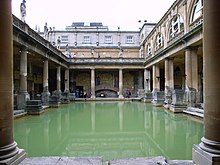
Roman public baths
(Thermae)
in
Bath
, England (Aquae
Sulis in the Roman province of
Britannia
).
The centre of the early social structure was the family, which was not only
marked by
blood relations
but also by the legally
constructed relation of patria potestas. The
Pater familias
was the absolute head of the
family; he was the master over his wife, his children, the wives of his sons,
the nephews, the slaves and the freedmen, disposing of them and of their goods
at will, even putting them to death. Originally, only patrician aristocracy
enjoyed the privilege of forming familial clans, or gens, as legal
entities; later, in the wake of political struggles and warfare, clients were
also enlisted. Thus, such plebian gentes were the first formed, imitating
their patrician counterparts.
Slavery
and slaves were part of the social
order; there were
slave markets
where they could be bought and
sold. Many slaves were freed by the masters for services rendered; some slaves
could save money to buy their freedom. Generally
mutilation
and murder of slaves was prohibited
by legislation. It is estimated that over 25% of the Roman population was
enslaved Professor
Gerhard Rempel
from the
Western New England College
claims that in the
city of Rome alone, during the Empire, there were about 400,000 slaves.
The city of Rome had a place called the
Campus Martius
(“Field of Mars”), which was a
sort of drill ground for Roman soldiers. Later, the Campus became Rome’s track
and field playground. In the campus, the youth assembled to play and exercise,
which included jumping,
wrestling
,
boxing
and
racing
.
Riding
, throwing, and swimming were also
preferred physical activities.
In the countryside, pastimes also included fishing and hunting.
Board games
played in Rome included
Dice (Tesserae or
Tali
), Roman Chess (Latrunculi),
Roman Checkers
(Calculi),
Tic-tac-toe
(Terni Lapilli), and
Ludus duodecim scriptorum
and Tabula,
predecessors of backgammon. There were several other activities to keep people
engaged like chariot races, musical and theatrical performances,
Clothing,
dining, and the arts

Fresco of a Roman woman from
Pompeii
, c. AD 50.
Roman clothing fashions changed little from the late Republic to the end of
the Western empire 600 years later. The cloth and the dress distinguished one
class of people from the other class. The tunic worn by
plebeians
(common people) like shepherds and
slaves was made from coarse and dark material, whereas the
tunic
worn by
patricians
was of linen or white wool. A
magistrate would wear the tunica augusticlavi; senators wore a tunic with
broad stripes, called tunica laticlavi. Military tunics were shorter than
the ones worn by civilians. Boys, up until the festival of Liberalia, wore the
toga praetexta, which was a toga with a crimson or purple border. The
toga virilis, (or toga pura) was worn by men over the age of 16 to
signify their citizenship in Rome.
The toga picta was worn by triumphant generals and had embroidery of
their skill on the battlefield. The toga pulla was worn when in mourning.
Even footwear indicated a person’s social status: patricians wore red and orange
sandals, senators had brown footwear, consuls had white shoes, and soldiers wore
heavy boots. Men typically wore a
toga, and women a
stola
. The woman’s stola looked
different from a toga, and was usually brightly coloured. The Romans also
invented
socks
for those soldiers required to fight on
the northern frontiers, sometimes worn in sandals.
In the later empire after
Diocletian
‘s reforms, clothing worn by soldiers
and non-military government bureaucrats became highly decorated, with woven or
embroidered strips, clavi, and circular roundels, orbiculi, added
to tunics and cloaks. These decorative elements usually consisted of geometrical
patterns and stylised plant motifs, but could include human or animal figures.
The use of silk also increased steadily and most courtiers of the later empire
wore elaborate silk robes. Heavy military-style belts were worn by bureaucrats
as well as soldiers, revealing the general militarization of late Roman
government. Trousers—considered barbarous garments worn by Germans and
Persians—were only adopted partially near the end of the empire in a sign for
conservatives of cultural decay. Early medieval kings and aristocrats dressed
like late Roman generals, not like the older toga-clad senatorial tradition.
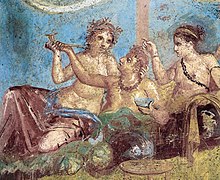
Roman fresco with banquet scene from the Casa dei Casti Amanti
(IX 12, 6-8) in Pompeii.
Romans had simple food habits. Staple food was simple, generally consumed at
around 11 o’clock, and consisted of bread, salad, cheese, fruits, nuts, and cold
meat left over from the dinner the night before. The Roman poet,
Horace
mentions another Roman favourite, the
olive
, in reference to his own diet, which he
describes as very simple: “As for me, olives,
endives
, and smooth
mallows
provide sustenance.” The family ate
together, sitting on stools around a table. Fingers were used to eat solid foods
and spoons were used for soups.
Wine was considered a staple drink, consumed at all meals and occasions by
all classes and was quite cheap. Many types of drinks involving grapes and honey
were consumed as well. Drinking on an empty stomach was regarded as boorish and
a sure sign for
alcoholism
, whose debilitating physical and
psychological effects were known to the Romans. An accurate accusation of being
an alcoholic was an effective way to discredit political rivals.
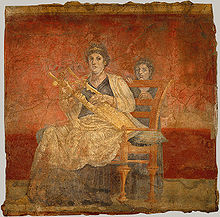
Woman playing a
kithara
, a wall mural from
Boscoreale
, dated 40–30 BC
Roman literature was from its very inception influenced heavily by Greek
authors. Some of the earliest works we possess are of historical epics telling
the early military history of Rome. As the empire expanded, authors began to
produce poetry, comedy, history, and tragedy.
Virgil
represents the pinnacle of Roman epic
poetry. His Aeneid
tells the story of flight of Aeneas
from Troy
and his settlement of the city that would
become Rome. The genre of satire was common in Rome, and satires were written
by, among others,
Juvenal
and
Persius
. Many Roman homes were decorated with
landscapes by Greek artists. Portrait sculpture during the period utilized
youthful and classical proportions, evolving later into a mixture of realism and
idealism. Advancements were also made in relief sculptures, often depicting
Roman victories.
Music was a major part of everyday life. The word itself derives from
Greek
μουσική (mousike), “(art)
of the
Muses
“. Many private and public events were
accompanied by music, ranging from nightly dining to military parades and
maneuvers. In a discussion of any ancient music, however, non-specialists and
even many musicians have to be reminded that much of what makes our modern music
familiar to us is the result of developments only within the last 1,000 years;
thus, our ideas of melody, scales, harmony, and even the instruments we use
would not be familiar to Romans who made and listened to music many centuries
earlier.
Over time, Roman architecture was modified as their urban requirements
changed, and the
civil engineering
and building
construction
technology
became developed and refined. The
Roman concrete
has remained a riddle, and even
after more than 2,000 years some Roman structures still stand magnificently.[76]
The architectural style of the capital city was emulated by other urban centres
under Roman control and influence.
Education
Following various military conquests in the
Greek East
, Romans adapted a number of Greek
educational precepts to their own system. Home was often the learning centre,
where children were taught
Roman law
,
customs
, and physical training to prepare the
boys for eventual recruitment into the
Roman army
. Conforming to discipline was a
point of great emphasis. Girls generally received instruction[78]
from their mothers in the art of
spinning
,
weaving
, and
sewing
.
Education nominally began at the age of six. During the next six to seven
years, both boys and girls were taught the basics of
reading
,
writing
and
arithmetic
. From the age of twelve, they would
be learning Latin
,
Greek
,
grammar
and
literature
, followed by training for
public speaking
.
Oratory
was an art to be practised and learnt,
and good orators commanded respect. To become an effective orator was one of the
objectives of education
and
learning
. In some cases, services of gifted
slaves were utilized for imparting education.
Economy
The invention and widespread application of
hydraulic mining
, namely
hushing
and ground-sluicing, aided by the
ability of the Romans to plan and execute mining operations on a large scale,
allowed various base and precious metals to be extracted on a proto-industrial
scale.
The annual total iron
output is estimated at 82,500 t,
assuming a productive capacity of c. 1.5 kg per capita.[81]
Copper
was produced at an annual rate of
15,000 t, and lead
at 80,000 t,[83]
both production levels not to be paralled until the
Industrial Revolution
;[84]
Spain alone had a 40% share in world lead production. The high lead output was a
by-product of extensive
silver
mining which reached an amount of 200 t
per annum.[86]
At its peak around the mid-2nd century AD, the Roman silver stock is estimated
at 10,000 t, five to ten times larger than the combined silver mass of
medieval Europe
and the
Caliphate
around 800 AD. Any one of the
Imperium’s most important mining provinces produced as much silver as the
contemporary
Han empire
as a whole, and more
gold by an entire order of magnitude.
The high amount of metal coinage in circulation meant that more coined money
was available for trading or saving in the economy (monetization).
Currency
The imperial government was, as all governments, interested in the issue and
control of the currency in circulation. To mint coins was an important political
act: the image of the ruling emperor appeared on most issues, and coins were a
means of showing his image throughout the empire. Also featured were
predecessors, empresses, other family members, and
heirs apparent
. By issuing coins with the image
of an heir his legitimacy and future succession was proclaimed and reinforced.
Political messages and imperial propaganda such as proclamations of victory and
acknowledgements of loyalty also appeared in certain issues.
Legally only the emperor and the Senate had the authority to mint coins
inside the empire. However the authority of the Senate was mainly in name only.
In general, the imperial government issued gold and silver coins while the
Senate issued bronze coins marked by the legend “SC”, short for
Senatus Consulto “by decree of the Senate”. However, bronze coinage could be
struck without this legend. Some Greek cities were allowed to mint[91]
bronze and certain silver coins, which today are known as Greek Imperials
(also Roman Colonials or Roman Provincials). The imperial mints
were under the control of a chief financial minister, and the provincial mints
were under the control of the imperial provincial procurators. The Senatorial
mints were governed by officials of the Senatorial treasury.
|














